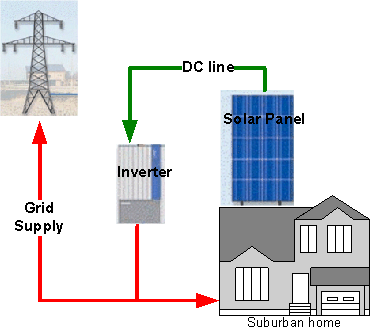Residential Grid-Tie Solar System
Home Grid Connected Solar Power
Grid-tie Solar Systems are connected directly to the utility grid (hence the name). They replace during day hours the utility electricity. Over the dark hours the utility is still your electricity supplier.
For two reasons it is a good idea to connect the on grid home power generating system to the grid bi-directionally:
- It is another revenue source that helps you to cover the capital expense (the utility pays you for electricity you sell to them)
- In some states only such systems (bi-directional monitoring grid connected solar) are entitled to tax debates (e.g. California).

That means you get a bi-directional meter that meters the electricity you buy from the utility (one direction) and the electricity you sell to the utility (the opposite direction). Some utilities pays you the same per KWh as you pay them. Some utilities pay you more. A good example is Israel (where I live), the utility pays 2.5 times more than what they charge.
The Components of the Grid Connected Solar Power System
The grid-tie solar system has only two major components and the meter
Usually, grid connected systems don't need a storage battery. The only reason to have a storage battery is to overcome grid electricity shutdowns, very rare in the US and in other developed countries. When the grid is up and running the utility is your backup with orders of magnitude more capacity than your home grid tie system capacity is. (1000s of Megawatts compared to a few Kilowatts)
Sizing Correctly The System
One question that I assume crossed your mind is how big your system is needed to be.
The answer is simple. Size the system taking into account three factors:
- How much roof area facing South or South East you can allocate to the solar panels
- What is your budget, take into account the tax credits and utility incentives
- How much your utility pays for electricity you sell them
Let me illustrate the step by step a ballpark estimation process for the size of the grid-tie solar system
- Look into your electricity bills and see what is your monthly average consumption in KWh (kilowatts-hour), as an example 600KWh.
- Divide this number by 30 to get the daily average consumption, in this example it is 20KWh per day.
- Divide by the useful average daylight hours, as an example take 6 hours. You get 3.3 KW or 3300 Watts AC power
- Divide by the efficiency of the inverter, as an example 90% (0.9). You get that roughly 3600 Watts of DC solar power is required
- Assuming you prefer a turn key job, the gross expenditure for 3600 Watts is around $15,000, after tax rebates it can drop to $10,000, depend in which state you live
- Scale the system size according to your budget. You can decide to go on <50%, 70%, 100% or even on more than 100%. This can be a modular approach. You can start with a smaller scale system and increase its size in the future
Cost, Shopping and installation
As a rule of thumb, the gross expenditure is $2-$3 per watt production capacity plus a couple of thousands $ for installation. Tax credits can cut 30-45% of this cost.
Decide what is the size of the system based on your allocated budget. Subsidized long term solar energy loans are available in some of the states
Next, find a solar contractor to come and survey the site and give you a technical proposal and a price quotation. If you plan to do it yourself, contact a good DIY solar store to get advice and a price quotation. In many states, state or utility tax debates are conditioned on bringing in a state certified solar contractor to do a turn key job
The life expectancy of a grid-tie solar system from a reliable source can be greater than 20 years. Maintenance cost is low, maintenance is limited mostly to cleaning the panels periodically
click here to return from grid-tie solar page to residential solar power page
click to view my Home Page
